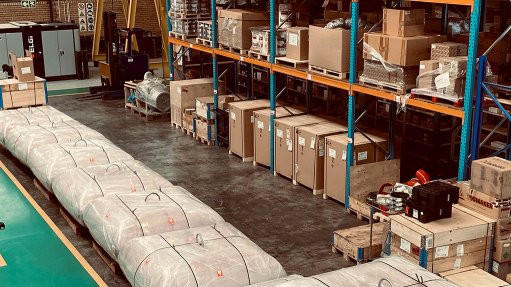
FLOATING STOCKS Integrated Pump Rental carries a comprehensive range of pump flotation devices
Every dewatering project is different, but most do require the use of accessories such as hosing and flotation systems.
While these accessories may seem to be just that, it is essential that when selecting the hosing and flotation system it is correctly matched to the dewatering pump and the application to ensure optimum operation.
Dewatering pumps specialist Integrated Pump Rental (IPR) carries a comprehensive range of pump flotation devices (PFD) and hose flotation devices (HFD) which are available for either purchase or hire.
IPR operations manager Henru Strydom explains that a PFD is used to suspend the pump during pumping operations to prevent it from burrowing into the bottom of the dam, stopes or pond where dewatering is being done.
“Using PFDs eliminates the situation where a pump could be damaged or even lost if it moves into the bottom of the area being pumped and, even more importantly, a PFD will significantly reduce the wear on the pump, since it is not in direct contact with the sediment at the bottom during pumping operations,” Strydom says.
The exterior of the PFD used by IPR is manufactured from low-density, high-strength polyethylene and is filled with polyurethane foam, which ensures that the flotation device will not sink, even in the unlikely event of the outer skin being punctured.
IPR supplies three different sizes of PFDs with carrying capacities of 250 kg, 600 kg and 1.2 t.
In the event that a heavier mass needs to be suspended, a number of PFDs can be used in series to accommodate this.
HFDs are used to suspend hoses during pumping applications where either pontoons or barges are used and the hose needs to be suspended above the water, or where hosing is laid across the water instead of around the perimeter of the water.
“In these instances, we advise customers to route the pipework across the direct line of sight to the barge or pontoon. This will result in substantial cost savings,” Strydom points out. The HFD from IPR has been engineered to accommodate cables that cover the same distance as the hoses. HFDs are available in all common hose sizes.
“All products used by IPR are ISO 9001 certified and advice on the most suitable flotation device for specific pump applications is provided by our experienced team. As with our pump offering, we take complete responsibility for all maintenance of flotation devices on site and we keep a comprehensive maintenance record. This allows our team to determine when proactive, scheduled maintenance is required and when equipment reaches end of life,” Strydom comments.
Meanwhile, IPR MD Lee Vine states that the success of IPR is rooted in its evolution from just renting diesel-driven dewatering pumps to designing and manufacturing fit-for-purpose solutions that are reliable and cost effective. He notes that off-the-shelf products often only serve the customer’s best-case scenario, and will fail to deliver the expected duty when conditions are more arduous. Further, customers will frequently need an urgent solution in the short term, but in the longer term must look for a design that is more sustainable. “At IPR, we respond to short-, medium- and long-term requirements,” Vine says. The company also has longstanding customers who were unable to source pump sets within a short lead time, so instead opted to procure their own pump sets. With its field experience, technical expertise and modern workshop, IPR can meet this need, by designing and building pump sets engineered specifically to suit the application. Its support services ensure that parts are readily available, and that regular maintenance can be conducted to ensure optimal uptime. “The solid performance of our team and our solutions is demonstrated by the fact that many customers who have asked for custom-built pump sets have previously rented pumps from us,” says Vine. “They were so impressed with our units, that they have taken the next step and acquired their own assets.”